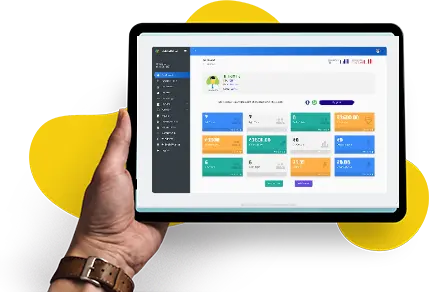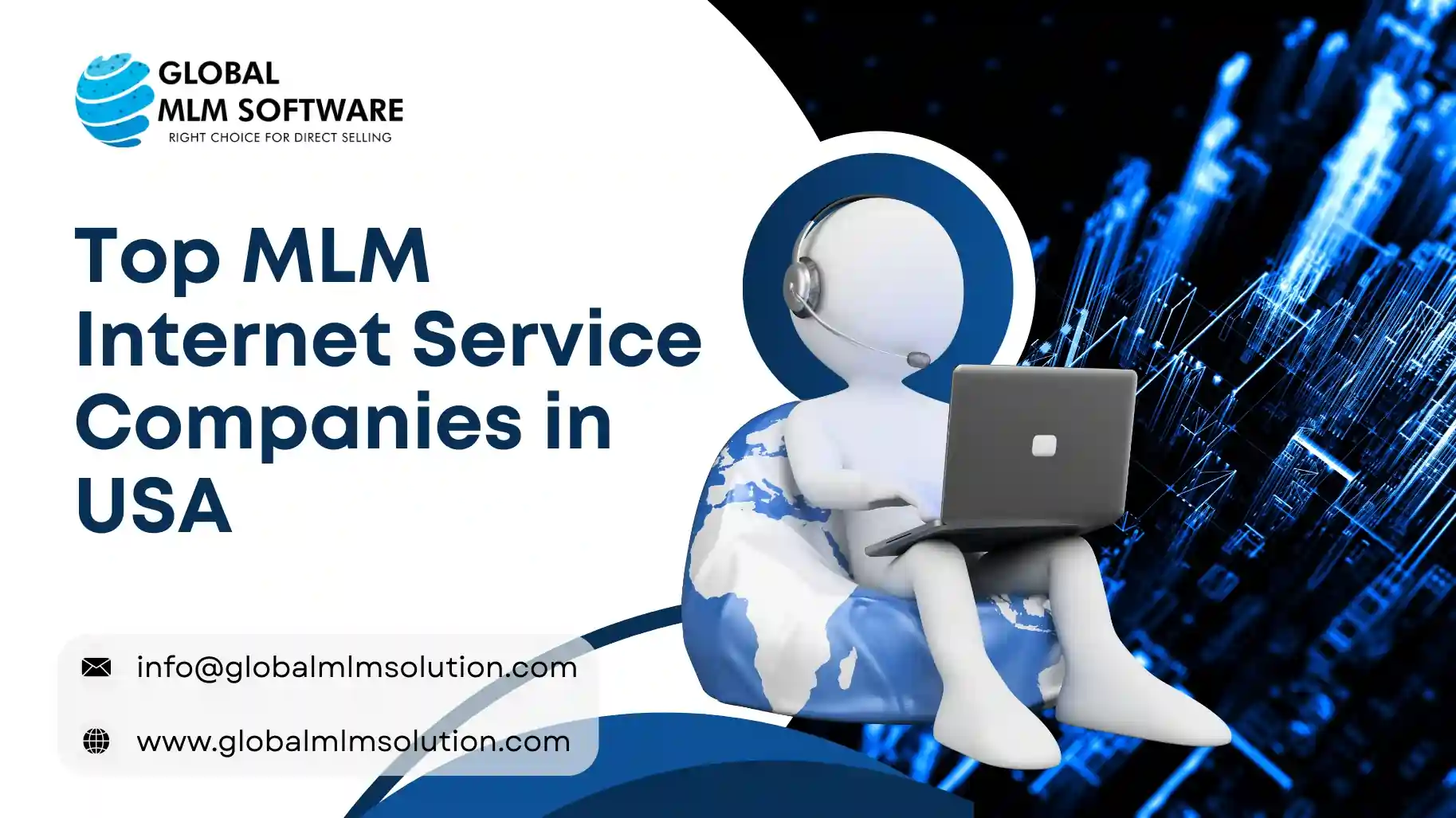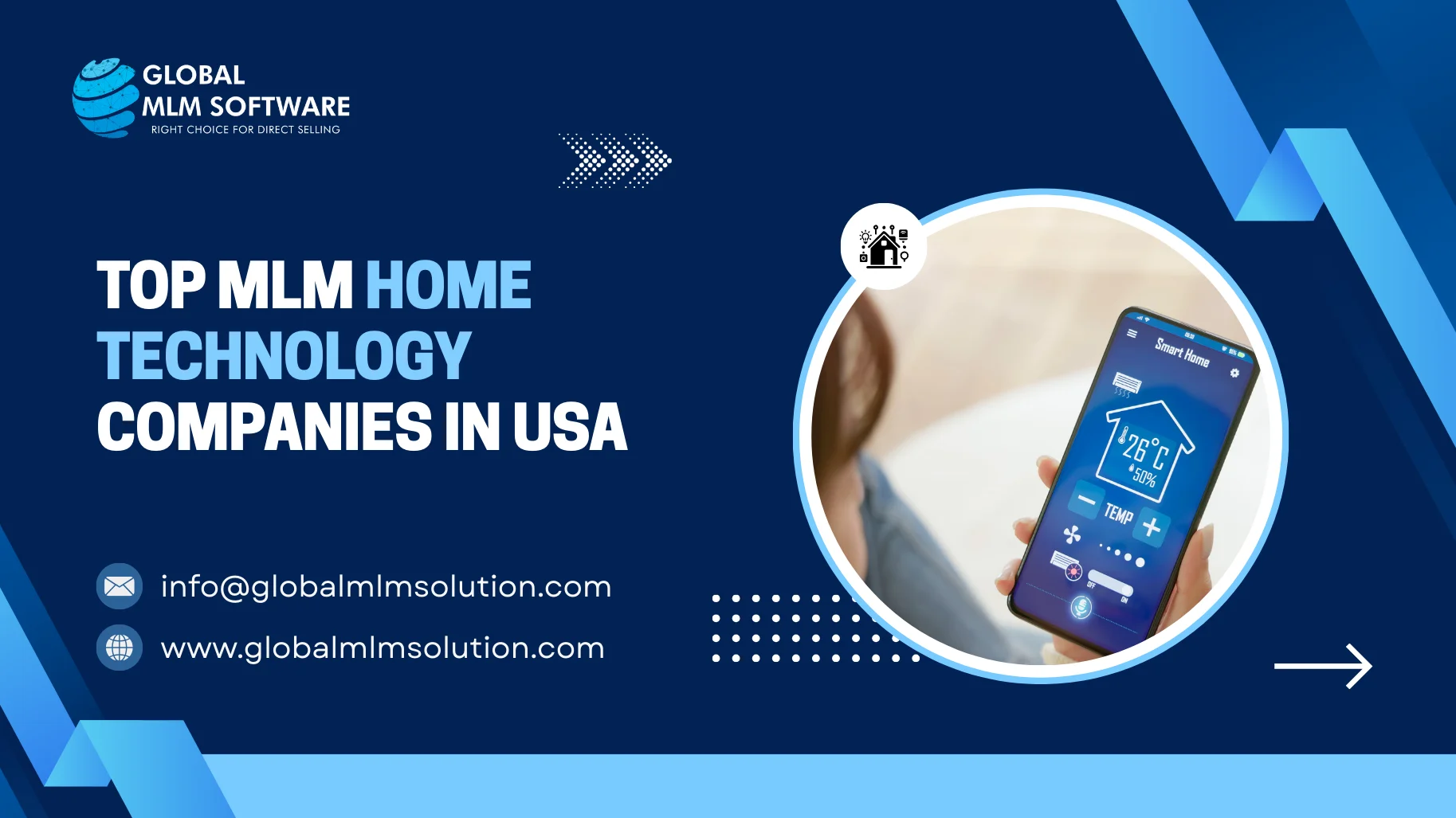A major revolution is taking place in the infinite sphere of trade, where conventional meets avant-garde. Our blog, "The Evolution of Direct Selling in the Digital Era," takes you on a riveting trip through the rich tapestry of direct selling's metamorphosis as we stand at the crossroads of history and innovation.
This Article Contains:
Exploration of Traditional Direct Selling Models and Their Adaptability to the Modern Landscape
Strategies for Integrating eCommerce into Direct Selling Models for a Broader Reach
Impact of CRM on Streamlining and Enhancing Direct Selling Processes
Role of Consumer Loyalty Programs in Fostering Long-term Customer Relationships
Case Studies Showcasing Successful Digital Transformations in Direct Selling
Emerging Trends and Advancing Technologies Shaping the Future of Direct Selling
Challenges and Opportunities in the Digital Evolution of Direct Selling
Expert Insights and Interviews on Navigating the Dynamic Landscape of Direct Selling
Summarizing Key Takeaways and Future Prospects for Direct Selling in the Digital Era
Introduction
James Robinson GravesBut is the father of direct selling. Rev. James Robinson Graves devised a business plan in 1855 that involved young men going door to door selling things. Direct selling was once characterized by only door-to-door sales, but those days are now long gone in this digital era.
Direct selling is a business model where products are sold directly to consumers away from a fixed retail location. An example would be a salesperson demonstrating products to potential customers in their homes. The oldest form of direct selling is peddling, which is the traveling from place to place carrying goods for sale. Peddlers would travel from town to town selling small goods like fabrics, tools or other merchandise directly to consumers.
During the COVID-19 pandemic, a large number of direct sellers quickly moved their companies online due to the lack of in-person contact. They introduced virtual product demos on Facebook Live and Zoom, enabling agents to engage with customers and bring on new subscribers securely. Customers now have access to more convenient shopping options thanks to digital tools, such as order-taking smartphone apps and 24/7 internet businesses.
From product marketing and customer connection building to hiring and educating independent sellers, this guide will examine the ways in which the sector has been affected by the digital transition. It will also uncover the advantages and difficulties of contemporary direct selling in the age of digital technology.
Historical Perspective of Direct Selling
The California Perfume corporation, now known as Avon, was founded in 1886 by David H. McConnell and is widely regarded as the first modern direct selling corporation.
The world's largest direct selling company is Amway, based in Ada, Michigan. Founded in 1959, Amway uses multi-level marketing strategies and had an estimated revenue of $8.8 billion in 2021. The term direct selling has garnered a lot of attraction and traction recently due to the digital revolution, but its origin dates at least a century back. There have been versions of direct selling for well over a hundred years.
In the late 1800s, Dr. James Robinson Graves Jackson launched one of the earliest known direct sales companies to sell health items directly to consumers. Direct selling has been around for centuries but the modern direct selling industry began emerging in the late 1940s and 1950s. Companies like Avon, Tupperware and Amway were founded during this time period and helped establish direct selling as a viable marketing channel.
The post-World War II era saw a substantial increase in direct selling as more women entered the workforce. In the 1950s and 1960s, companies like Amway and Mary Kay started direct selling on multilevel marketing platforms, enabling individuals to construct sales teams. This business model allowed sales agents to profit from their sales and those of the customers they signed up with. Businesses were able to expand thanks to its viral marketing rapidly.
The late 20th century saw a Digital evolution of direct selling worldwide thanks to transportation and communication improvements. Advertising and marketing have adapted to the proliferation of mass media devices like televisions and telephones. Pampered Chef started airing cooking shows on television in the 1980s to promote their products. In addition, catalogs have become a direct sales tool by facilitating at-home purchases.
Direct selling started booming and became a multibillion-dollar industry during the late 1990s and 2000s. Companies were aggressively utilizing direct selling to expand their presence to emerging markets of Asia and Latin America. For instance, the popularity of traditional store-front businesses suffered a major setback with the emergence of e-commerce.
However, until recently, the fundamental direct sales model of interpersonal contacts remained analog. Direct marketing was about to undergo yet another sea change with the advent of social media and online shopping.
Exploration of Traditional Direct Selling Models and Their Adaptability to the Modern Landscape
A direct selling model is a marketing strategy where a company sells its products directly to consumers through independent representatives rather than through retail stores. The core marketing strategy of direct selling involves independent sales representatives marketing and demonstrating products directly to customers, often in home parties or social media settings.
This allows for personalized product explanations and builds social relationships between distributors and customers that can help drive repeat sales and referrals.
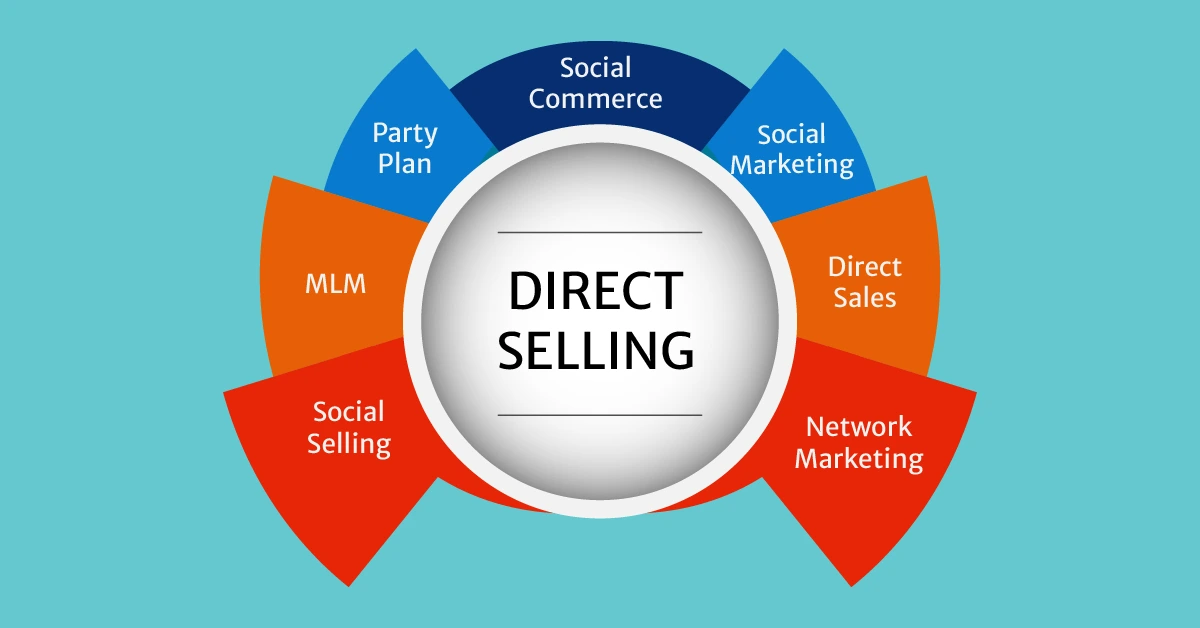
The process of direct sales involves directly engaging with potential customers, presenting products or services, addressing their needs or concerns, and closing transactions to complete the sale. The three main types of direct selling are single-level direct, party-plan, and multi-level marketing.
1. Single-level direct
In this type of direct selling, individual sales representatives sell products directly to consumers. Representatives may work as independent contractors or distributors for a company, earning commissions on their sales. This model often involves person-to-person sales, home parties, or demonstrations where the representative showcases and sells products directly to potential customers.
2. Party Plan
Direct sellers engage in "party plan" activities by hosting in-home product demos. Companies like Tupperware and Avon built their early success on the party plan concept in the mid-20th century. Representatives would demonstrate the latest things to social circles while developing a sense of community.
Virtual events have brought the party into the digital age. Digital catalogs and samples can be freely distributed without physical copies. You can avoid the hassle of traveling altogether by hosting your party online; it's just as entertaining as being there in person. Now, sellers who operate out of their homes may connect with buyers across the nation and perhaps the globe.
3. Multi Level Marketing
Representatives in multilevel marketing organizations earn money from their own sales and the sales of others they recruit. This strategy, popularized by Amway and Mary Kay, expanded rapidly through word of mouth. The recruitment power of social media in the digital age cannot be overstated. Salespeople can use their web connections to acquire new staff and conduct virtual orientations. The signup procedure is streamlined thanks to integrated back offices.
Mobile apps that have been streamlined for use on the go can also help with recruitment and sales. The ability to manage employees, monitor sales, and place purchases remotely is a massive boon to entrepreneurs. Companies now provide courses on digital branding and content strategies to assist salespeople in expanding their online presence and finding new clients or employees.
Both party plans and multilevel marketing methods have proven highly adaptable to virtual situations. The foundations of social contact and network expansion are unaltered by the advent of direct selling in the modern age, facilitating greater reach, efficiency, and scalability. Traditional direct sellers who have embraced digital transformations have a good chance of succeeding in the 21st-century market.
Adaptability of Traditional Direct Selling to Modern Landscape
Companies that engage in direct selling in the modern age have shown remarkable flexibility in adapting traditional direct selling models in their operations to the realities of the Internet Age and consumerism. Despite its foundation in face-to-face communication, the sector has increasingly turned to online platforms to maintain its network effects.
Facebook Live and Zoom have become popular venues for direct salespeople to host online versions of their in-person product demos and recruitment drives. In this way, agents may confidently interact with big groups of people in any part of the world. Independent vendors now have access to a helpful digital infrastructure, including mobile apps and online back-office tools.
The digital evolution of direct selling enables direct merchants to reach a far wider audience and find new consumers with the help of social media. Skillful use of social media marketing on sites like Facebook, Instagram, and TikTok assists in drawing digital product launch and promotion crowds online.
In modern direct selling, representatives increasingly approach customers through social media platforms and online product demonstrations rather than just in-person. They connect with potential buyers through social networks, send product information over messaging apps, and host virtual parties or tutorials to showcase items on video calls from the comfort of people's homes.
Remote recruitment of additional independent vendors is also facilitated by online networks and influencer connections.
Traditional direct sales techniques have been shown to adapt traditional direct selling models well in an online setting. Established social models in the industry can thrive in the digital age since digital tools merely provide new accessible avenues for them to do so. Its adaptability makes direct selling a viable business option for years to come.
Strategies for Integrating eCommerce into Direct Selling Models for a Broader Reach
In e-commerce, direct selling refers to a business strategy in which transactions occur directly between the vendor and the customer, doing away with the necessity for intermediaries like physical retail locations. E-commerce is a form of direct selling that involves selling products or services directly to consumers.
A direct selling strategy involves selling items or services to consumers directly through personalized encounters, avoiding intermediaries and frequently adopting means such as in-person demonstrations, social selling, or e-commerce.
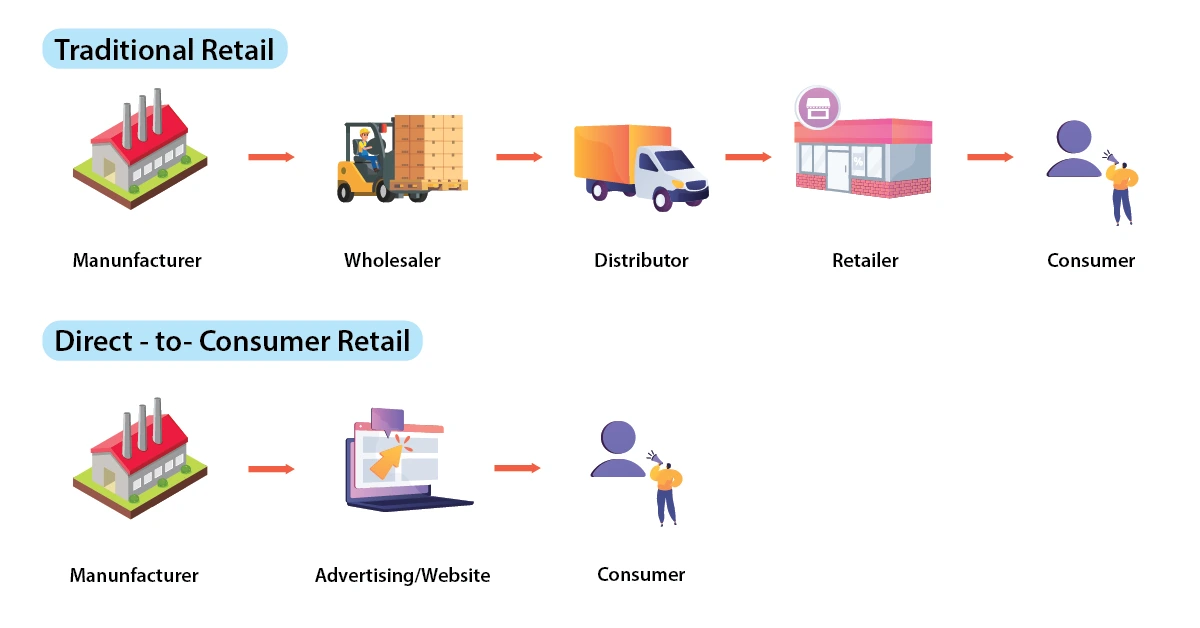
Understanding direct selling in the modern age as a whole is the first step in incorporating eCommerce strategies in direct selling into conventional direct selling models. Online platforms, social media, and e-commerce websites all have their own nuances that sellers must learn to exploit. Doing so requires keeping up with the most recent developments and consumer habits in the online space, in addition to building an actual presence there.
1. Online Stores
Online stores are one of the most obvious ways for eCommerce strategies in direct selling. These allow users to browse products and make purchases conveniently 24/7 from any device. Mobile-friendly websites for retail outlets are a must. By connecting retailers with popular social media sites, merchants may make it simple for their customers to post product links. Positive product evaluations and testimonials can bolster online shoppers' confidence in a business.
2. Social Selling
Social selling is one of the best and most effective strategies that direct selling in the modern age embraces. Any eCommerce strategies in direct selling should prioritize leveraging social networks. Facebook and Instagram allow vendors to broadcast live events like product launches and demonstrations.
In addition, they can market their web stores by making a Facebook Business page under their own name. Get your goods in front of your ideal customers using hashtags and tailored marketing. Reps can direct message contacts and post to groups and marketplaces to obtain sales leads.
3. Influencer Partnerships
An organization can increase its online visibility by teaming up with popular social media users who have built active fan bases. Sponsored content and product stories are an excellent way for influencers to reach their audiences. Rewarding influencers with affiliate codes or commissions for referrals encourages sustained marketing efforts. Micro- and macro-influencers, with narrow and broad audiences, drive traffic to e-commerce sites.
4. Content Marketing
Blogs and videos that educate customers and increase brand awareness may do wonders for a business's online presence. Lifestyle and how-to articles highlight the product's practicality while building credibility for the company. Recommendations are improved by user-generated content from delighted consumers. Content that has been effectively optimized for search engines and promoted through social media marketing can reach large, new audiences.
5. Payment Gateways
Integrating eCommerce strategies in direct selling means simplifying the buying process. Technology may help direct sellers streamline their operations, from accepting payments online to fulfilling customers' orders quickly. It's crucial to provide intuitive interfaces and support for mobile devices to satisfy today's digital consumers' wide range of tastes.
6. Analytics and Retargeting
Top-performing content, best-selling products, and receptive demographics can all be gleaned from examining website and social media statistics. Then, the adverts are redirected to people who have already interacted with them using retargeting technology, returning them to the online store. A customer's experience from discovery to purchase can be improved with the help of data-driven tactics.
Also Read: Role of eCommerce in Direct Selling: Trends and Innovations
Impact of CRM on Streamlining and Enhancing Direct Selling Processes
CRM or customer relationship management can include direct selling. CRM systems often help direct selling companies manage relationships with their independent sales representatives and track customer interactions and sales. The field of direct selling has been revolutionized by customer relationship management (CRM), which is changing how companies communicate with and learn about their clients.
CRM and direct selling help allocate responsibilities to the appropriate sales reps, track each salesperson's success, and save time by automating the computation of commissions. CRM and MLM software for direct selling business solutions are now fundamental to any direct sales operation's success due to the growing importance of one-on-one interactions.
1. Centralized Customer Information
One of the critical contributions of CRM and direct selling is the aggregation of client information into a centralized database. In more traditional approaches, it may be challenging to accommodate everyone's unique interactions and preferences.
CRM systems facilitate this procedure by keeping track of each customer's preferences, purchasing history, and demographic information. Thanks to this consolidated database, direct sellers can gain the insights they need to modify their strategies and provide more relevant services to their clientele.
2. Improved Communication and Engagement
By equipping direct sellers with tools to connect with customers at just the right time and via the most appropriate channels, CRM and direct selling paves the way for more productive information exchanges. In order to ensure that consumers always receive up-to-date and relevant information, CRM systems incorporate automated communication capabilities that allow for individualized messages.
This allows direct sellers to improve consumer engagement and cultivate relationships through strategic communication methods, including email campaigns, social media interactions, and individualized promotions.
3. Enhanced Sales and Marketing Strategies
Sales and marketing operations can significantly benefit from CRM and direct selling systems. Data analysis lets Direct marketers learn about consumer habits, tastes, and preferences. This knowledge allows for creating more specific advertising and promotional initiatives, increasing the effectiveness of sales efforts. By allowing direct salespeople to identify and focus on the leads with the greatest potential for conversion, CRM software helps them make the most efficient use of their time and energy.
4. Streamlined Order Processing and Inventory Management
Efficient order processing is crucial in direct selling, and CRM solutions contribute significantly to streamlining this area of the organization. By syncing up with stock-keeping software, businesses can monitor their inventory in real-time and avoid problems like overselling and running out of stock. By eliminating unnecessary steps, direct sellers can quickly fulfill orders, increasing consumer happiness and loyalty.
5. Personalization at Scale
Successful direct selling relies heavily on personalization, and customer relationship management (CRM) technologies make it possible to do so at scale. Direct marketers can provide more relevant product recommendations and promotions using information about their customers' buying habits. Increased sales and loyal customers are two byproducts of this kind of customization, which also boosts customer happiness.
6. Data-Driven Decision Making
Data-driven decisions made possible by customer relationship management solutions equip direct sellers with actionable knowledge. Businesses can improve their product lineups, price points, and advertising campaigns by analyzing customer data trends and performance metrics. With this analytical capacity, direct sellers can stay ahead of the competition and adjust quickly to market changes.
7. Efficient Team Collaboration
Teamwork is essential for direct sales groups. CRM and direct selling systems serve as a hub where teams can discuss and plan how to serve customers best. This collaborative approach guarantees that every team member is well-informed about customer contacts, reducing duplication of efforts and boosting the overall efficiency of the sales team.
8. Enhanced Customer Retention
Proactive customer care, made possible by CRM, is a significant factor in increasing CRM's contribution to customer retention. Direct sellers implementing CRM systems can better anticipate customers' demands and respond quickly to their problems, increasing customer happiness and loyalty. Positive customer experiences are cultivated through automated follow-ups, reminders, and personalized gestures, boosting sales and word-of-mouth advertising.
Also Read: Unlocking the Power of CRM in Direct Selling
Role of Consumer Loyalty Programs in Fostering Long-term Customer Relationships
Customer experience and loyalty programs in direct selling have grown increasingly important these days. These loyalty programs in direct selling incentivize long-term customer loyalty and spending. Direct sellers sometimes offer their clients tiered loyalty programs in which they can earn points toward future discounts, free products, or other rewards with each purchase they make. Over several months or years, a customer can earn promotions from bronze to silver to gold.
1. Incentivizing Repeat Business
Loyalty programs offer clients real rewards for sticking with a specific brand. These programs give customers an incentive to come back for more purchases, whether in the form of points, discounts, or unique benefits. Businesses encourage the notion that recurring business is valued and appreciated by offering loyalty rewards.
2. Building Emotional Connections
Loyalty programs foster emotional bonds between brands and their clientele that go beyond straightforward business dealings. Businesses show that they genuinely care about the wants and preferences of their consumers by providing personalized rewards and taking into account individual preferences. This emotional connection creates a strong sense of loyalty and belonging that extends beyond the actual good or service.
3. Encouraging Brand Advocacy
Happy and devoted consumers are more inclined to promote a brand. Loyalty programs that include social sharing opportunities or referral rewards maximize word-of-mouth marketing. Customers who believe they are getting great value and advantages become passionate brand ambassadors, telling their networks about their wonderful experiences.
4. Gathering Customer Insights
Loyalty programs are an excellent way to get customer information and insights. With these tools, businesses can monitor customer preferences, purchasing trends, and behavior. Businesses can then use this data better to align their marketing strategies and services with customer expectations, resulting in a more relevant and personalized customer experience.
5. Enhancing Customer Retention
Improving client retention may be the most apparent effect of loyalty programs. Customers are less likely to seek alternatives as they collect awards and reap loyalty benefits. A loyalty program is a strategic and economical way to keep current consumers at a lesser cost than bringing in new ones, which is why it's essential for long-term business success.
Also Read: Proven Techniques For Building Customer Loyalty in Direct Selling
Data Analytics and Personalization in Direct Selling
Data analytics is becoming indispensable for understanding customers and tailoring engagement as direct selling moves online more and more. When marketing automation technologies are combined with CRM systems, large behavioral data is captured.
Finding out which products people browse, buy, and review might yield useful information. Based on buying patterns and historical data, businesses can more accurately estimate demand and manage inventory. Knowing which promotions and content generate the most significant interest, they may tailor their marketing approaches.
Personalization engines use data to deliver customized messages automatically. Personalized product recommendations are given to customers. Relevance is increased via tailored messaging, such as birthday and seasonal promotions. Reminders for abandoned carts entice potential customers back. Direct sellers also use analytics to customize outreach.
CRM relationship profiles enable sales representatives to have deeper conversations by giving them access to a prospect's hobbies, past purchases, and pain areas. Using data to match representatives with customers based on demographics, geography, and other criteria improves those crucial one-on-one interactions.
Emergence of Influencer Marketing in Direct Selling
There have been several direct selling industry shifts, such as significant growth thanks mainly to influencer marketing. Influencers use their vast and active social media followings to reach a wider audience with products and business prospects. These days, numerous direct merchants operate affiliate programs that pay micro-influencers to recommend goods and increase sales. Representatives also collaborate with industry macro-influencers with audiences of tens of thousands or more.
Influencers use posts, stories, and videos on social media sites like YouTube, Instagram, and TikTok to produce sponsored content highlighting products. Recommendations from users they already follow are trusted by their followers. These promotions' links and codes directly link sales and recruiting.
Successful influencer marketing programs raise brand exposure and consideration among new audiences. Influencer recommendations are more effective at reaching younger audiences than traditional advertising. By tracking their outcomes, direct selling organizations can find the most effective influencer partners for continuing promotions. Influencer marketing has become a pivotal component of the industry's digital expansion due to its affordability.
Case Studies Showcasing Successful Digital Transformations in Direct Selling
As per Statista Report in 2022, analysts forecast that by 2026, spending on global digital transformation will reach $3.4 trillion.
Businesses now need to look around them for inspiration from the success stories of digital transformation if they want to achieve company efficiency and top-line revenue growth. These three intriguing Suyati case studies demonstrate how innovative businesses in various industries use digital technology to stay one step ahead of competitors.
Case Study 1: Improving Delivery Processes to Increase ROI
A prominent Japanese wholesale distributor of liquid fuels wished to investigate digital transformation options to improve the order-delivery chain. Delivery of petroleum and petroleum products to construction sites in Tokyo and the surrounding areas has been their target market for more than 40 years.
The business could not acquire quick operational benefits despite no direct rivalry in the industry. There were numerous obstacles, including uneven deliveries that led to unfavorable customer reviews, challenges finding the precise delivery location in sizable construction sites, and a steady stream of calls from call centers and customers that distracted drivers while driving.
Reexamining the company's mobile application for drivers and customers was the first step before approaching a digital solution. Most of the drivers' and customers' pain problems were resolved when it streamlined the process in emergency situations (such as undelivered orders) and offered real-time order delivery status notifications.
The introduction of microservices architecture, higher customer engagement, employee satisfaction, and increased ROI are just a few of the fantastic outcomes of the Japan-based company's digital transformation initiatives.
Case Study 2: Establishing an Omnichannel Presence to Reach New Audiences
After realizing the millennial generation's expanding needs, a well-known seafood supplier was eager to establish an omnichannel presence. The company aimed to become the top online seller of frozen seafood by leveraging cutting-edge technologies to reach new business heights.
The most significant obstacle was finding and delivering fresh seafood. It was essential to keep the cold chain intact from the point of purchase to the point of delivery because the products were perishable. However, the absence of an efficient distribution chain resulted in high costs and a poor return on investment.
They used a three-phase strategy for digital transformation: demonstrate, scale, and transform. This method helps reinforce the organization's four main pillars: customer acquisition, operations, culture, and business model. From creating an advanced online store to implementing a fully automated home delivery system, a series of revolutionary solutions were implemented.
The digital transformation project produced incredible outcomes. First, the business created a new revenue stream in the B2C market by utilizing a tailored e-commerce platform to enable cross-border direct sales to clients. The staff members were equipped with readily available intelligent navigation and logistics alternatives to guarantee straight delivery in the quickest amount of time with the least amount of work.
The most well-liked takeaway was the data mining tools that provided campaign strategies and tailored marketing to increase consumer engagement and attract new clients. The best thing, though? The staff quickly embraced the revolutionary new business model without requiring them to get familiar with the intricate underlying technological infrastructure.
Case Study 3: Developing a Successful Lead Management System to Boost Sales Conversions
An international self-publishing business with over 200,000 published writers was confronted with an enormous obstacle: an excessive number of leads coming in through various methods. The company's lead management efforts degraded significantly as the volumes rose.
Upon approaching a digital solution, the company's business dilemma became evident. The lead management process lacked the capacity and resources to effectively track and convert the 800 fresh leads generated daily on average by the sales and marketing departments, API interfaces, and website forms.
They tasked a highly skilled, international team with creating an automated module that uses an online analytical processing (OLAP) search technique to identify duplicates from lead entry history and combine data to guarantee the accuracy of the current lead data. They collaborated with a vendor to incorporate information intelligence that would cleanse and enhance lead information to guarantee authenticity and stop the company from handling erroneous or fraudulent data.
Additionally, by implementing a changeable lead scoring model, the company could modify the criteria in response to current market trends. The organization managed lead configurations, such as score thresholds, timeouts, notification intervals, lead release mechanisms in the event of API failures, etc., using the newly built lead management portal.
Emerging Trends and Advancing Technologies Shaping the Future of Direct Selling
The future of direct selling is being shaped by a convergence of transformative trends in direct selling and cutting-edge technologies. The continuing integration of new technologies, as well as a greater emphasis on individualized and immersive client experiences, are likely to determine the future of the direct selling market. Technology has transformed direct selling by giving worldwide reach via online platforms and e-commerce, allowing representatives to use social media for client connection, tailored marketing, and data-driven insights.
All these add to the transformation of the way businesses connect with consumers. Trends in the industry are likely to continue evolving, with a potential focus on advanced technologies, personalized customer experiences, and innovative strategies to adapt to changing consumer preferences. Here are some of the direct sales trends: Augmented and Virtual Reality, Artificial Intelligence, Blockchain etc.
1. Augmented and Virtual Reality
Virtual reality (VR) and augmented reality (AR) offer new, immersive methods to experience things without actual samples. Representatives may "place" furniture in houses or virtually try cosmetics using AR filters on social media. Customers can virtually inspect large-scale objects or tour reconstructed stores by donning VR headsets. Those younger audiences who are used to interactive material may find these creative demo alternatives appealing. Direct sellers need to develop their extended reality skills.
2. Artificial Intelligence
Artificial Intelligence (AI) assistants using natural language processing respond to basic consumer inquiries 24/7. When it's not during business hours, chatbots and virtual agents can answer simple questions about products and refer more complicated ones to real people. AI further improves CRM solutions through predictive analytics.
The future point of direct selling lies in further embracing AI technologies and social selling online. AI assists businesses in personalizing communications and offers by spotting trends in the behaviors of both buyers and sellers. Routine direct selling tasks will become increasingly automated with the help of AI over time.
3. Blockchain
Blockchain networks offer fresh approaches to rewards and verification. Smart contracts carry out automated loyalty point redemptions and seller commission payments. Distributed ledgers also improve supply chain tracking for products with ethical sourcing by increasing transparency. NFTs (non-fungible tokens) have the potential to make digital collectibles a direct selling product. Blockchain technology presents an opportunity, provided businesses investigate suitable uses that benefit clients and agents.
4. Live Streaming Commerce
Virtual product launches and demonstrations are increasingly being conducted virtually using live streaming platforms such as Facebook Live and Instagram Live. Interactive live streaming allows vendors to answer audience inquiries while showcasing products in real-time. Consumers connect with representatives and find the encounter to be engaging. Social media is what propels sales. There will be an increase in direct selling through these impromptu, conversational styles as live-streaming commerce expands.
Also Read: Direct Selling Industry trends, Growth & Forecast in 2023
Challenges and Opportunities in the Digital Evolution of Direct Selling
Direct selling's digital growth presents various opportunities and challenges that reshape how firms interact with customers in a world where connectivity is becoming increasingly critical. The challenges of direct selling include potential resistance from customers due to negative stereotypes, regulatory complexities, and the need for continuous recruitment and training of sales representatives. Success in the digital sphere for direct selling depends on managing these challenges.
Challenges
1. Transitioning Traditional Sellers
Transitioning seasoned personnel accustomed to analog models to digital platforms takes considerable training. Potential attrition may result from older sellers' resistance to technological advancements. To help all representatives adjust, companies must progressively implement virtual systems and offer continuing technical support.
2. Information Overload
The volume of information that independent sellers must handle can be daunting due to the frequent changes on social media and direct messages. Businesses must train representatives in time management and strategic content planning for social selling.
3. Maintaining Personal Touch
Despite the convenience and scale digital tools offer, direct selling is still a relationship-based industry. Businesses should promote in-person gatherings and one-on-one video chats to sustain the interpersonal relationships essential to success.
4. Security and Compliance
Direct selling is an online business that deals with payment security, data privacy, and legal and regulatory compliance issues in a complicated digital environment. Robust security procedures and compliance education are essential.
Direct selling offers opportunities for flexible entrepreneurship, personalized customer engagement, and the potential for income growth through commission structures and team-building in a variety of product and service sectors.
Opportunities
1. Global Markets
Through the use of mobile commerce and virtual technologies, geographical obstacles are eliminated, allowing direct sellers to enter new worldwide markets. The centralization of digital content and tools opens up access to international markets.
2. Personalized Engagement
Communications can be made highly individualized for each client and agent using CRM systems and behavioral data. Engagement is maintained by personalized material, which doesn't increase information overload.
3. Recruiting Younger Talent
Younger generations accustomed to technology find direct selling appealing if it embraces digital tools and interactive live broadcasting. Innovative virtual systems on social media platforms will help businesses draw in new representatives comfortable with digital networking and sales.
Expert Insights and Interviews on Navigating the Dynamic Landscape of Direct Selling
1. Insights from Industry Leaders
Direct selling executives provide valuable perspectives on navigating the evolving industry:
The president of a global direct seller notes virtual platforms have "expanded our reach tenfold." She advises companies to test new technologies continuously.
An Amway VP says their research found reps crave online communities amid isolation. Amway focused on strengthening digital support systems and social connections.
A marketing director at Avon emphasizes the importance of personalized CRM data. She shares how they optimized communications based on customer profiles and purchase histories.
2. Interview with a Top Direct Seller
Jenna Zwagil a CMO and founder of MyDailyChoice earning six figures annually, discusses her experience transitioning to social selling:
She leads the strategic marketing management and creative direction of a global wellness firm that offers various brands, including HempWorx, the fastest-growing CBD brand in the world. With my enthusiasm for innovation and perfection, I have scaled our firm from $10M to over $100M in annual revenue in just one year and created half a billion in sales for HempWorx.
She notes the key is consistency: "Post valuable content daily, engage comments, and constantly promote your business opportunity."
3. Advice from an Industry Analyst
According to AR and VR Market Report, the AR/VR market will expand from a starting value of $23000 million in 2023 to a total value of $160000 million by 2031, representing a compound annual growth rate (CAGR) of 38.17%.
This research covers all aspects of the Augmented Reality and Virtual Reality (AR and VR) business in the direct selling industry, from a high-level study of the overall market size, industry chain, and market dynamics to more detailed data on market segmentation by type, application, and region. It accomplishes this by integrating extensive quantitative and qualitative investigation.
Summarizing Key Takeaways and Future Prospects for Direct Selling in the Digital Era
This guide has discussed the remarkable digital evolution of direct selling into an industry primarily focused on digitalization. The traditional method of conducting business, consisting of in-home parties and face-to-face recruitment, has been revolutionized through the creative utilization of e-commerce platforms, virtual events, social media, and mobile technology.
Companies that traditionally engage in direct selling have shown themselves to be highly adaptive to direct selling in the modern age by moving their primary social and networking activities online. Existing party plans and multilevel marketing structures are thriving in the virtual world. New developments such as live-streaming commerce and augmented reality have opened new opportunities for product demonstrations and worldwide outreach.
The future of direct sales in the next five years is likely to see further digitization, increased reliance on artificial intelligence, continued expansion of e-commerce integration, and a focus on sustainability and social responsibility.
Using digital tools such as customer relationship management (CRM) systems and influencer marketing has helped expedite business processes while also improving the experiences of customers and representatives. Innovative and long-term involvement can be cultivated through the use of loyalty programs. The optimization of communications and retention across distant networks can be accomplished through data-driven personalization.
Keeping up with the constant changes by Transformative trends in direct selling poses several obstacles and opportunities. The most successful businesses will provide their salespeople with cutting-edge training. This methodology balances digital and personal interactions and proactive management of problems such as information overload and regulatory compliance.
Direct selling is primed to continue its rapid evolution, with new developments on the horizon, like integrating blockchain technology, immersive augmented reality, and interfaces powered by artificial intelligence (AI). This robust industry can ensure its continued relevance in modern commerce and provide chances for independent business owners since it has embraced digital change. Those who are successful in direct selling will be those who can learn and adjust continuously.
Even in this new digital era, Direct selling industry shifts have an optimistic outlook for the future. Those businesses that put the needs of their customers first, provide their employees the autonomy they need to do their jobs well, and stay abreast of developing tendencies will be successful for many years to come.
Are you ready to transform your direct selling strategy? With Global MLM Solution, you may explore endless possibilities. With our cutting-edge Global MLM software, you can take your business to the next level in the digital age. Partner with Global MLM Solution right now to begin a path of growth, innovation, and unrivaled network management.
Global MLM Solution is a pioneer in developing cutting-edge software solutions for the ever-changing world of multi-level marketing. Our MLM software helps businesses to succeed in the digital era by offering a powerful platform for efficient network administration and exceptional development. We are committed to innovation and smooth integration. With Global MLM Solution, you may improve your direct selling experience by combining technology with success.
FAQs
1. What impact has the digital revolution had on conventional direct selling methods?
The key impact the digital revolution had on conventional direct selling are Online presence and Ecommerce platforms, Social Media and Networking, Data Analytics and Personalization, Mobile Technology etc.
2. How important is social media in the advancement of direct selling?
There are several factors where social media plays a key role in the advancement of direct selling are Increased reach and visibility, Customer engagement and relationship building, Social selling and Ecommerce integration, Influencer collaborations, Real time updates and announcements, Data Analytics and Insights etc.
3. How can firms overcome the obstacles of using digital direct selling strategies?
Overcoming the obstacles associated with digital direct selling strategies requires a thoughtful and strategic approach. Here are specific steps that firms can take to address common challenges such as Invest in employee training, Address privacy and security concerns, Adapt to changing consumer behavior, Effective use of social media, Customer education etc.
4. How can successful direct selling organizations stand out in the digital age?
In the digital age, successful direct selling organizations can distinguish themselves by adopting strategic approaches that leverage the opportunities presented by digital technologies. Here are key strategies to help direct selling organizations stand out. They are Strategic use of social media, Omnichannel presence, Personalization and CRM, Ecommerce Integration, Customer education and training, Data Security and Privacy Assurance etc.




